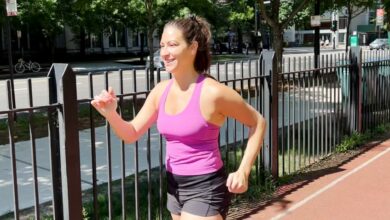I’ve been taught that if someone attending my fitness class falls off the step or tumbles on the studio floor, I should not stop the class. Rather I should keep the rest of the class in continuous motion, before running to help the felled client. I’ve been doing that when needed, but still I feel an urge to jump off my step and help the individual up when such an incident happens.
That moment of panic, however, is easily overcome when you know the basic rules of helping an injured person in the studio class. Today I'll share some of these rules with you.
You can place injuries occurring in a fitness class in three different categories: Swelling, acute injuries and chronic injuries.
Swelling is caused by inflammation or bleeding in or around an injured area. Its the body's response to injuries. It’s a simple condition that requires rest, application of ice on the inflammation area for 20 minutes at a time and as often as possible for the first 48 hours, compression of the affected area, and elevation of the injured limb. The simple act of Rest, Ice, Compression and Elevation is referred to as RICE.
Acute injuries relate to a specific accident with specific symptoms (limited range of movement, pain in the injured area, etc.). This kind of injury is treated with RICE and immediate medical consul. You may have pulled a muscle or broke a bone and the fact that you did so while working out might prevent you from knowing the actual range of pain, given your body is at a high temperature due to your exercise and the natural painkillers in your system that are working to the max.
Chronic injuries are basically symptoms with no cause. You probably don’t remember the cause of a certain back pain that keeps bugging you over the years, but you are by now familiar with the discomfort, swelling and/or pain that comes with these kinds of injuries. Chronic injuries might improve by applying the RICE rules, but the best advice here is to attend a specialist.
Finally, when you are suffering from tenderness at a specific point with an area that is one to two fingers wide, on a part of your body that is close to the bone, then a bone fracture is the suspected culprit. You should seek an orthopedist and request the injured part be x-rayed. in the meantime, using RICE can ease the pain in the area until you see a doctor.
Other than classroom-accident related injuries, some injuries occur when the fitness enthusiast is fatigued, or has recently changed their workout style (different type of class, frequency or intensity). This kind of injury is most common at the foot, ankle, knee and lower back. They are easily diagnosed and simply treated by RICE.
To avoid injuries in the classroom, maybe you can follow these simple tips on keeping fit and staying safe:
1. Don’t overdo it:
I know you want to lose these couple of kilos before your wedding day/ the swimming pool party/ the wet t-shirt contest, but you should not start an intensive workout routine without proper preparation. Gradually, safely and effectively increase your workout intensity in order to avoid injuries.
2. Take time to warm up, cool down:
Jumping to the beat is fun, but if you did not take your time to warm up, your muscles might not see what’s coming and won’t have the time to loosen up before working out. The same goes for cooling down. You need to reduce the risk of injuries by taking couple of minutes after your workout and before hitting the locker room to stretch your body properly. This will prevent lactic acid build-up and any unnecessary injuries that might occur if you simply walk out of the class and head on with the rest of your day.
3. Footwear counts:
Before you do a certain fitness workout, ask your instructor for recommendations on the best workout footwear. I know brand sportswear is extremely expensive, but if you are thinking of partaking frequently, you'd do best to prevent injury by investing in appropriate shoes.
4. Spice up your workout:
Some people think that its a great deal of fun to do one kind of fitness classes only–like jazz dance, Latin dance, step, or aerobics–but doing such puts your body at risk of injury. You might be able to improve your posture, flexibility and strength if you joined a different style of class–such as toning, Yoga, or Pilates–once or twice a week.




